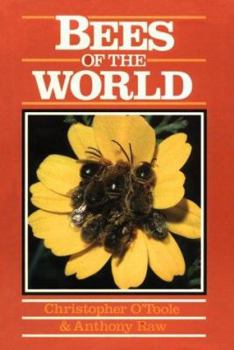Bees of the World
Select Format
Select Condition 
Book Overview
The diversity of lifestyle, behavior, and life cycles that bees possess, makes the task of creating a well-rounded reference about them a daunting one. However, Bees of the World presents... This description may be from another edition of this product.
Format:Hardcover
Language:English
ISBN:0816019924
ISBN13:9780816019922
Release Date:January 1992
Publisher:Facts on File
Length:192 Pages
Weight:0.05 lbs.
Dimensions:0.8" x 6.5" x 9.6"
Customer Reviews
3 ratings
Great book
Published by Thriftbooks.com User , 13 years ago
This is a truely excellent book, especially for entomologists who should have an interest in bees. The only problem I have is that the picture on the cover is actually of a fly.
A Book for a Lifetime
Published by Thriftbooks.com User , 15 years ago
I hope this -- now labelled "young adult" -- version hasn't been watered down from the 1999 edition. I read mine again every year or so -- it's that interesting and that deeply detailed, and the pictures are wonderful. The adaptations of bees to their environments -- or perhaps the ability of bees to construct their larvae's environments by drilling, cutting, and complex building techniques-- were a revelation to me 10 years ago and still are. It's a sad commentary on the publisher that, as an eagle-eyed reviewer detected, the cover picture certainly does seem to feature a fly -- a bee-imitating fly but a fly nonetheless. Perhaps this is why clicking on the cover to "look inside" (and try to get a better look at the cover insect) brings up the wonderful picture from the older edition rather than that from the new -- a cluster of bees (a 'lek') putting themselves to be on the disk of a sunflower. Just one of the fascinating aspects of bee behaviour the book tells about. A great companion to Gary Nabhan and Stephen Buchmann's "Forgotten Pollinators" and a must pair for plant lovers who ask "what's happening" while watching wild and garden plants.
The world is a beehive
Published by Thriftbooks.com User , 15 years ago
The world is a beehive, and I just stepped right into it! Most people assume that there is only one kind of bee: the honeybee (with the killer bee as an unfortunate spin-off). I certainly thought so, until I read this book. Actually, there are about 25,000 different species of bees! You heard me. Not twenty-five, but twenty-five THOUSAND. How's that for a mindjob? Apart from "our" Western honeybee, there are mining bees, mason bees, carpenter bees, leaf-cutter bees, even sweat bees. And, of course, bumblebees! I always thought that bumblebees weren't really bees, but belonged to a different category altogether, rather like hornets or ants. That's certainly how the common man in Sweden sees the situation. Every non-biologist or school teacher talk about bees, hornets and bumblebees as if they were three different things. In reality, bumblebees are very closely related to honeybees. The British authors of "Bees of the World" even say that bumblebees are more "bee-like" than honeybees. I suppose this is why British bee books sometimes put a bumblebee on their front cover - it's considered archetypically, Platonically bee-ish by the general public. Nobody in Sweden would agree. An interesting cultural difference! I was even more surprised to learn that many of the solitary bees (mason bees, etc) can be found right here, in Europe. I must have encountered them many times over, but never noticed, simply assuming that they were odd-looking honeybees. Finally, "Bees of the World" solved another mystery from my childhood: Who makes circular holes in the leaves of rose bushes? We knew that a nasty neighbour sometimes stole the flowers, but this... It's the bees, stupid! "Bees of the World" is a real nerd book, written by two enthusiasts for other enthusiasts. I must admit I'm now one of them. I've read almost the entire book from cover to cover in just five days. The authors mentions the honeybee only in passing, and concentrate on the lesser known bee families, giving rather detailed information on pretty much everything from their nests and mating habits, to their intricate social behaviour and even parasites. Even the "solitary" bees turn out to be quite social, and some of the parasites are other bees! There are also sections on the interaction between bees and flowers (the chapter on orchids being particularly intriguing), drones (some of them roost like birds), cuckoo and robber bees, bees that nest in empty seashells, and "stingless" bees that can fry your skin instead, giving you terrible burns! The only thing conspicuously missing are the killer bees - just one picture of those. Recommended, if you can tear yourself from that honeyjar of yours. PS. Is the insect on the front-cover really a bee? It looks like a DRONE FLY! :-D




